Find an angle in the given quadrilateral
Let $AD\cap BC=\{E\}$.
Thus, since $$\frac{AE}{CE}\cdot\frac{CE}{DE}\cdot\frac{DE}{BE}\cdot\frac{BE}{AE}=1$$ we obtain: $$\frac{\sin50^{\circ}}{\sin20^{\circ}}\cdot\frac{\sin60^{\circ}}{\sin50^{\circ}}\cdot\frac{\sin(70^{\circ}-x)}{\sin{x}}\cdot\frac{\sin80^{\circ}}{\sin30^{\circ}}=1$$ or $$\frac{\sin(70^{\circ}-x)}{\sin{x}}=\frac{\sin20^{\circ}\sin30^{\circ}}{\sin60^{\circ}\sin80^{\circ}}.$$ But it's obvious that $x$ is an acute angle and $\frac{\sin(70^{\circ}-x)}{\sin{x}}$ decreases.
Id est, it's enough to prove that: $$\frac{\sin10^{\circ}}{\sin60^{\circ}}=\frac{\sin20^{\circ}\sin30^{\circ}}{\sin60^{\circ}\sin80^{\circ}}$$ or $$2\sin10^{\circ}\sin80^{\circ}=\sin20^{\circ},$$ which is obvious.
We draw first the red rhombus $ABFE$ with angles $100^\circ$ and $80^\circ$. Then we draw the lines $g$, $h$ through $A$ and $F$ which make an angle of $20^\circ$ with two sides of the rhombus. Due to symmetry these lines intersect at a point $D$ on the symmetry axis $BE$ of the rhombus. All black noted angle sizes in the figure can now be immediately verified. It is easily seen that all angles at $D$, in particular the angle $x$, are $60^\circ$.
Since $|CF|=|EF|$ the triangle CFB is isosceles. This certifies the $50^\circ$ of the median angle at $C$, and in a second step the $50^\circ$ of the lower angle there, as well as the angle $30^\circ$ at $B$. It follows that our quadrilateral $ABDC$ is a copy of your $ABDC$.
